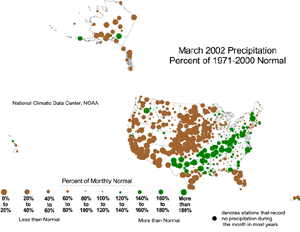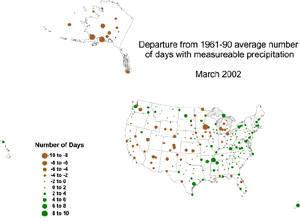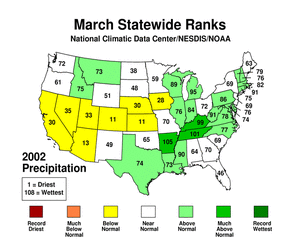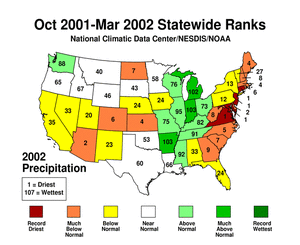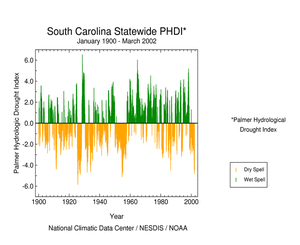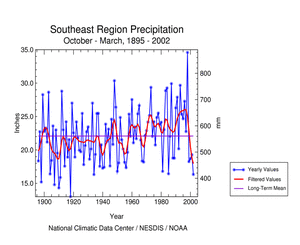National Overview
On the national scale,
|
 |
 |
Although some areas of the U.S. had above normal precipitation, many areas were very dry. Integrated across the nation, March 2002 precipitation averaged near normal. Twelve of the last 31 months have averaged well below the normal, while only three averaged well above normal (see graph to right). National 2001-2002 precipitation ranks:
|
 |
Regional Overview
Across the western U.S., beneficial precipitation during March continued a gradual amelioration in drought conditions in the Pacific Northwest and parts of the northern Rockies while dryness intensified across much of California to Colorado and New Mexico and the Texas Trans-Pecos region.
Beneficial precipitation also brought short-term relief to parts of the eastern U.S. this month, but long-term drought continued its stranglehold across the eastern seaboard.
Dry conditions during March in parts of the central and southern Plains continued a pattern of longer-term dryness in some areas.
March was generally drier than normal across most of Alaska and at the primary stations in the southern islands of Hawaii. Snowpack at the end of March was below average across much of northern, western, and interior Alaska.
This overall pattern is evident in the following indicators:
Two other drought-related monitoring tools are the Vegetation Health Index and the Keetch-Byram Drought Index:
|
Western U.S. Drought
|
March continued the precipitation pattern of recent months, with Pacific storms bringing limited drought relief to the northern portions of the western U.S. while the southern portions continued dry. On a regional basis, the Pacific Northwest had the 39th wettest March in the last 108 years, while March 2002 ranked 31st driest in the West region and 19th driest in the Southwest. Reservoir levels across the West were still generally below-average, reflecting dry conditions in the very long-term (24 months or longer).
The rainy season (October-March) for the West region started out wet, but the last three months have been drier than normal regionwide (see graph below left). January-March 2002 ranked as the seventh driest January-March on record for the region (see graph below right). The last 12 months ranked as the 24th driest April-March on record for the region. |
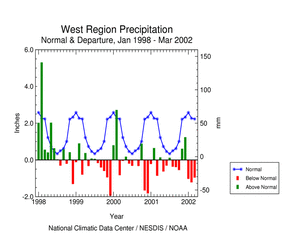 |
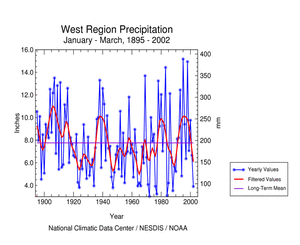 |
| The Southwest region has experienced persistently dry conditions for much of the last ten months (see graph below left). Mountain snowpack was considerably below average, with snow water equivalent ranging from 25 to 50 percent of average, or less, in many areas. January-March 2002 ranked as the third driest such year-to-date on record regionwide, with other notable ranks (see table below right) including the sixth driest April-March (see graph below right) and second driest September-March. |
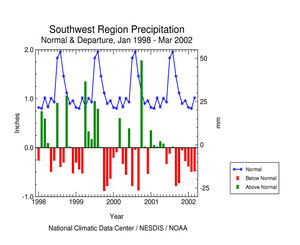 |
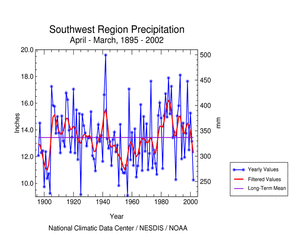 |
Drought impacts in the western U.S., as compiled by the National Weather Service / Climate Prediction Center:
USA Today reported that Utah "faced its worst drought since the 1930s". The Associated Press reported that U.S. Agriculture Secretary Ann Veneman declared Montana a drought disaster area near the end of March. |
|
Central U.S. Drought
| March 2002 was unusually dry across parts of Kansas, Oklahoma, and southern Texas. This month was a continuation of dryness for some of these areas, especially southern Texas, while other parts of the northern and central Plains have experienced dryness on the longer term (see map below left). Kansas had the fourth driest October-March in the last 108 years during 2001-2002 (see graph below right). |
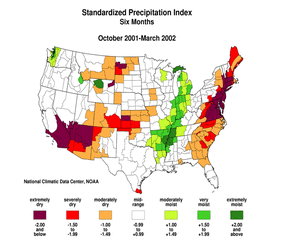 |
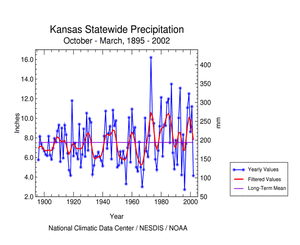 |
Drought impacts, as compiled by the National Weather Service / Climate Prediction Center:
|
Eastern U.S. Drought
| March was wet across portions of the Northeast and Southeast regions, with dry conditions dominating central and southern Florida (see map below left). On a regionwide basis, the Northeast had the 36th wettest March and the Southeast the 45th wettest March in the last 108 years. However, long-term drought remained a problem as the last six months were an extremely dry period in some places (see map below right). April 2001-March 2002 was the driest such 12-month period on record for Maine and second driest for New Hampshire, New Jersey, and South Carolina. |
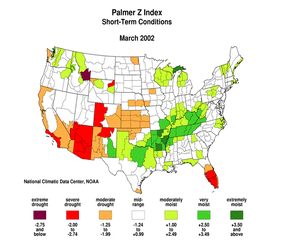 |
 |
Drought impacts in the northeastern U.S., as compiled by the National Weather Service / Climate Prediction Center:
|
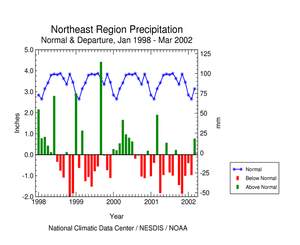
|
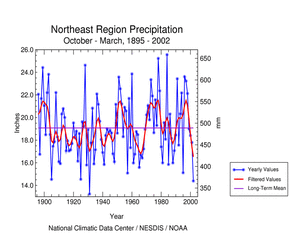 |
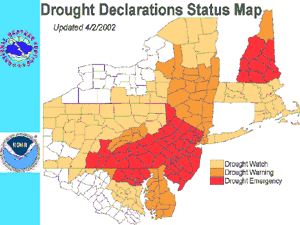 |
Drought impacts in the southeastern U.S., as compiled by the National Weather Service / Climate Prediction Center:
Drought impacts in South Carolina, as reported by the State Climate Office:
|
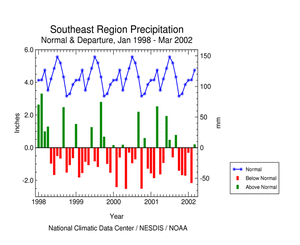
|

Additional Contacts:
Damage due to the drought has been summarized by NOAA and the Office of Global Programs in the Climatological Impacts section of the Climate Information Project. Crop impact information can be found at the USDA NASS (National Agricultural Statistics Service) and Weekly Weather and Crop Bulletin pages. Drought statements by local National Weather Service Offices can be found at the NWS Hydrologic Information Center. Drought threat assessments and other information can be found at NOAA's Drought Information Center. Additional drought information can be found at the National Drought Mitigation Center, the USDA's National Agricultural Library, the interim National Drought Council, and the NOAA Paleoclimatology Program. The following states have set up web pages detailing current drought conditions and/or their plans to handle drought emergencies:
For additional information on current and past wildfire seasons please see the National Interagency Fire Center web site or the U.S. Forest Service Fire and Aviation web site. NCDC's Drought Recovery Page shows the precipitation required to end or ameliorate droughts and the probability of receiving the required precipitation. Additional climate monitoring graphics can be found at the Climate Prediction Center's monitoring pages:
Drought conditions on the Canadian prairies can be found at the Agriculture and Agri-Food Canada Drought Watch page. |
 NOAA's National Centers for Environmental Information
NOAA's National Centers for Environmental Information
